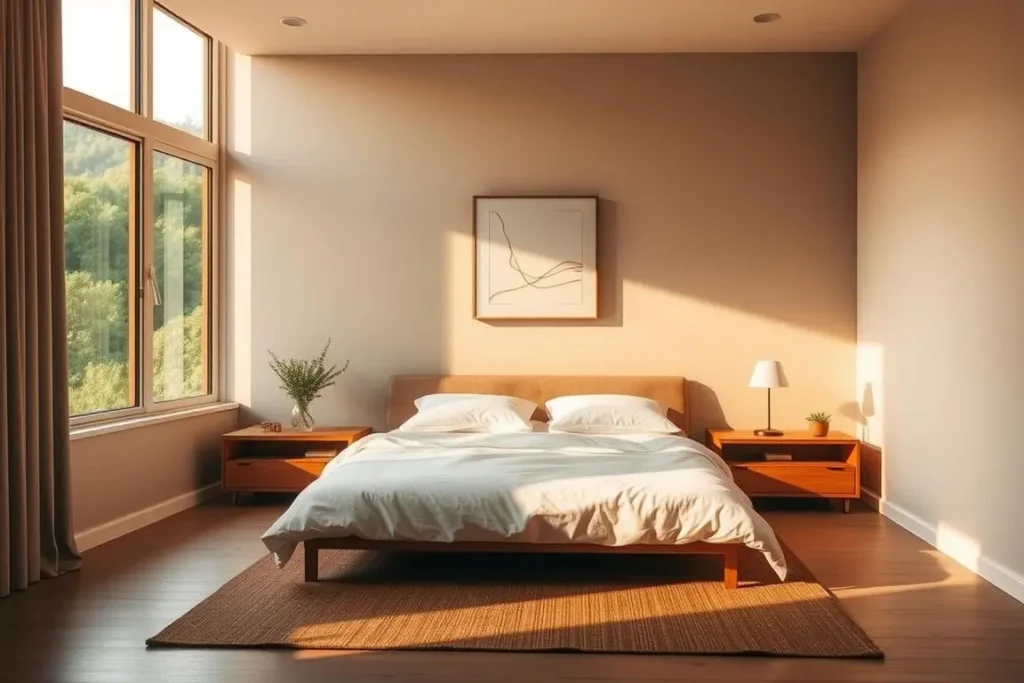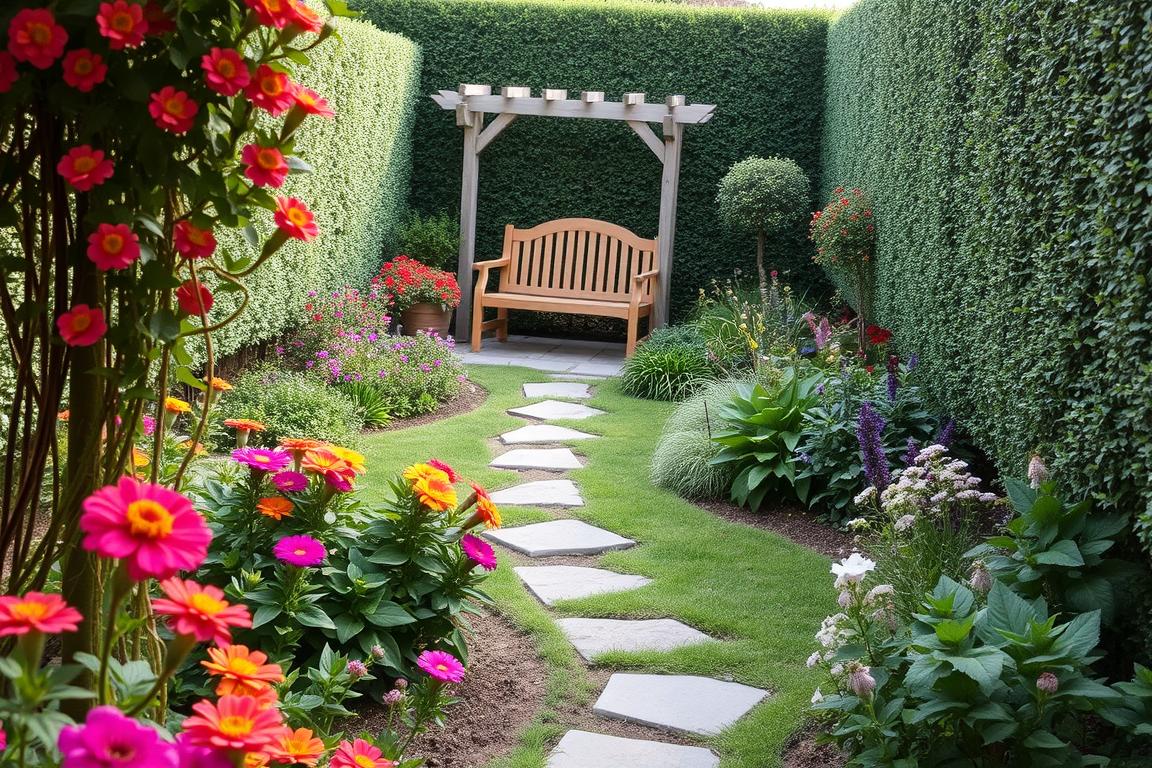Creating a natural sleep environment is key to better sleep. You can do this by setting up your bedroom for sleep. This includes using tips to make your sleep space better. A well-designed sleep area can boost your health, energy, and overall well-being.
Improving sleep quality starts with your bedroom. By using Natural Sleep Environment Tips, you can wake up feeling refreshed. This can help you tackle daily tasks with more energy and focus.
To better your sleep, focus on a natural sleep environment. Simple changes to your bedroom can greatly improve your rest. Use Natural Sleep Environment Tips to make your bedroom a sleep-friendly space that promotes relaxation and rejuvenation.
Table of Contents
ToggleIntroduction to Better Sleep
By prioritizing sleep and creating a natural sleep environment, you improve your health and well-being. This article will explore the importance of a natural sleep environment. We’ll also provide tips on creating a sleep-friendly space, including how to improve sleep quality and set up your bedroom for better sleep using Natural Sleep Environment Tips.
Key Takeaways
- Creating a natural sleep environment is essential for improving sleep quality
- A well-designed sleep space can lead to better physical and mental health
- Using Natural Sleep Environment Tips can enhance your rest and overall well-being
- Improving sleep quality starts with your bedroom setup for better sleep
- Prioritizing your sleep can have a positive impact on your daily life
- Incorporating Natural Sleep Environment Tips into your daily routine can lead to better energy levels and focus
- Setting up your bedroom for better sleep is critical for restful and rejuvenating sleep
Understanding the Importance of Sleep Environment
Creating a restful sleep space is key to better sleep. When you enhance sleep environment, you boost sleep hygiene habits. This leads to better physical and mental health. A well-designed sleep area greatly improves your well-being.
To make a restful sleep space, think about these things:
- Lighting: Dim red lights help set your sleep-wake cycle.
- Noise: A quiet place helps you fall asleep quicker and sleep better.
- Temperature: A cooler room helps you sleep better.
Adding these elements makes a restful sleep space for better sleep. Remember, sleep hygiene habits are vital for health. As you enhance sleep environment, remember it takes time and effort.
By focusing on your sleep area, you’ll wake up feeling great. Start making your dream sleep space today. Enjoy the perks of a restful sleep area.
Elements of a Sleep-Friendly Room
To make your bedroom sleep-friendly, focus on several key elements. A good bedroom is not just about looks. It’s about creating a space that helps your body and mind relax. By adding the right touches, you can sleep better and wake up feeling great.
Ideal Temperature and Humidity Levels
The best sleep temperature is between 60-67 degrees Fahrenheit. The humidity should be between 30-50%. Keeping these levels can help your body stay comfortable while you sleep. Use a thermostat and humidifier to keep your bedroom just right for sleep.
Choosing the Right Bedding Materials
Choosing the right bedding is important for a sleep-friendly room. Look for breathable fabrics like cotton or linen. Also, pick pillows that support your neck and head well. Some great options include:
- Bamboo sheets
- Wool blankets
- Down comforters
These materials help keep your body at the right temperature. They make your bed comfortable, helping you sleep better and creating a peaceful bedroom.
Light Control for Better Sleep
Creating a healthy sleep environment is key for a good night’s sleep. Light control is often overlooked but is very important. Light in the evening can mess with your sleep cycle, making it hard to sleep well. To sleep better, you need to think about tips for better sleep environment, like controlling light.
A dark room is best for sleep because it helps your body’s natural rhythms. Even a little light can stop your body from making melatonin, the sleep hormone. To keep your room dark, use blackout curtains or shades. You can also try earplugs and an eye mask.
Effects of Light on Sleep Quality
Light can really affect how well you sleep. The blue light from phones, tablets, and computers can mess with your melatonin levels. To avoid this, try not to use screens for at least an hour before bed.
Tips for Blocking Out Light
Here are some tips for better sleep environment to block out light:
- Use blackout curtains or shades to block out external light
- Try using earplugs and an eye mask to block out any remaining light
- Avoid screens for at least an hour before bedtime
- Use dim red lights instead of bright white lights in the evening
Noise Management for Sleep
To get better sleep, it’s key to think about how noise affects you. Your bedroom should be set up to block out noise. Start by finding out where the noise comes from and how to lessen it.
Effective ways to handle noise include earplugs, white noise machines, or soundproofing your room. Soundproofing means sealing gaps, using acoustic panels, or adding soundproofing materials. This helps make your sleep area quieter, leading to better sleep.
Here are more tips to manage noise and sleep better:
- Use a fan or a white noise machine to create a constant, soothing sound
- Install acoustic panels or soundproofing materials in your room
- Seal gaps and cracks around doors and windows to prevent noise from entering
- Consider using earplugs or earmuffs to block out noise
By using these methods, you can make your bedroom better for sleep. This will help you sleep better and wake up feeling good.
Aromatherapy and Sleep
Consider adding aromatherapy to your Natural Sleep Environment Tips. It can help you relax and sleep better. Certain essential oils are known to calm the mind and body.
Essential oils like lavender and chamomile are great for calming. You can use a diffuser to spread their scent in your room. This creates a peaceful space for you to relax before bed. Or, you can apply them to your skin through massage or by adding them to your bath water.
- Use high-quality essential oils that are pure and potent
- Experiment with different oils to find what works best for you
- Use aromatherapy in combination with other Natural Sleep Environment Tips, such as keeping your room cool and dark
Adding aromatherapy to your sleep routine can make your sleep better. Just remember to use essential oils safely and follow the right guidelines.
The Role of Color in Sleep Environments
Creating a restful sleep space involves many factors, including colors. Colors can affect your mood and emotions. Certain hues can help you sleep better. For example, blue and green are calming. They can reduce stress and anxiety, making it easier to sleep.
A well-designed sleep environment can improve your sleep quality. Choosing the right colors for your bedroom can create a calming atmosphere. Here are some tips to help you get started:
- Use soothing colors on walls and bedding to create a peaceful ambiance.
- Avoid using bright and bold colors, as they can stimulate your brain and interfere with sleep.
- Consider using a color scheme that promotes relaxation, such as shades of blue, green, or neutral tones.
By following these tips, you can create a restful sleep space. This can help you sleep better and improve your overall sleep quality. Remember, a well-designed sleep environment is key for a good night’s sleep. So, take the time to create a space that promotes relaxation and calmness.
Technology and Sleep Quality
Creating a healthy sleep environment is key for a good night’s sleep. The impact of technology on sleep is often overlooked. In today’s world, using electronic devices before bed is common but can harm your sleep. It’s important to consider technology’s role and take steps to reduce its impact.
The Negative Effects of Screen Time Before Bed
Using electronic devices before bed can mess with your body’s natural sleep cycle. The blue light from screens can lower melatonin levels, the sleep hormone. This can make it hard to fall and stay asleep. To improve sleep, avoid screens before bed or use blue light filtering glasses or apps.
Solutions for Reducing Tech Disruptions
To lessen tech’s impact on sleep, try these tips:
- Use blue light filtering glasses or apps
- Avoid electronic devices at least an hour before bed
- Have a bedtime routine without screens
By following these strategies, you can make a sleep-friendly environment. This will help you sleep better and feel better overall.
Decluttering for a Better Sleep Space
To get better sleep, you need a sleep-friendly space. A messy room can mess with your mind, making it hard to relax. This can lead to poor sleep.
Clutter can overwhelm your brain, making it hard to calm down before bed. A tidy bedroom is key for a good night’s sleep.
Decluttering your room can make it peaceful, helping you relax. Here are some tips to start:
- Use storage containers to keep things organized and hidden
- Make cleaning a regular part of your routine
- Follow a “one in, one out” rule to avoid clutter
These tips can help you make a sleep-friendly bedroom. A clean room is just the beginning. With these steps and other sleep tips, you’ll wake up feeling great.
The Importance of a Routine
To improve your sleep, it’s key to have a regular sleep schedule. Going to bed and waking up at the same time every day helps your body adjust. This routine makes it simpler to fall and stay asleep.
A bedtime routine tells your brain it’s time to sleep. This makes it easier to relax and calm down. Natural Sleep Environment Tips suggest activities like reading, warm baths, or deep breathing or meditation to help you wind down.
Having a regular sleep schedule boosts your sleep quality, energy, and health. By focusing on sleep and setting a bedtime routine, you’re on the right path. To better your sleep environment, try these tips:
- Stick to a consistent sleep schedule
- Create a relaxing bedtime routine
- Make your sleep environment comfortable and inviting
Furniture Arrangements for Optimal Sleep
To make your bedroom a place for rest, think about how you arrange your furniture. The spot where you place your bed is key to good sleep. Arrange your furniture to make your bedroom a calm and peaceful place.
Here are some tips for bed placement:
- Put your bed away from the door for more security and less noise
- Don’t place your bed under a window to avoid drafts and noise
- Think about the room’s energy flow and arrange furniture for calmness
Choosing the right furniture is also important. Look for pieces that are comfy, useful, and look good. A good mattress, for example, can greatly improve your sleep. A well-set-up bedroom helps you sleep better and feel refreshed in the morning.
Don’t forget about other furniture like dressers, nightstands, or desks. Make sure these aren’t too crowded. Clutter can make your room feel chaotic and hurt your sleep. By picking and placing your furniture wisely, you can make a sleep-friendly space that helps you relax and sleep well.
Indoor Plants for Improved Sleep
Creating a healthy sleep environment is key for a good night’s rest. Indoor plants play a big role in this. They improve air quality and help you relax, making your sleep better. To do this, pick plants that are easy to care for and thrive indoors.
Some top plants for sleep include snake plants, spider plants, and peace lilies. They clean the air and help you relax. Adding these plants to your room can make it calm and restful, helping you sleep well.
Benefits of Indoor Plants
Indoor plants are great for sleep, with many benefits:
- They improve air quality by taking in carbon dioxide and releasing oxygen.
- They help you relax, reducing stress and anxiety.
- Being around plants can also make you feel happier and more well.
Choosing the Right Plants
When picking plants for your sleep space, think about these things:
- Lighting: Pick plants that do well in low light, like Chinese Evergreen or Pothos.
- Maintenance: Choose plants that are easy to care for, like succulents or air plants.
- Allergies: If allergies are a problem, go for plants that are hypoallergenic, like orchids or bromeliads.
By adding indoor plants to your sleep space and following these tips, you can make a healthier sleep area. This area will promote relaxation and improve your sleep quality, giving you a restful and refreshing sleep.
Creating a Cozy Atmosphere
To improve sleep quality, focus on your bedroom setup. A cozy atmosphere can greatly enhance your rest. Think about the textures and lighting that help you relax. Soft blankets, plush carpets, and comfy pillows make your space cozy.
Warm lighting is also key. Table lamps or string lights can create a calming vibe. They help you relax before bed. Adding these elements can make your bedroom better for sleep and waking up feeling good.
- Adding plants with soft leaves or flowers to bring in a natural touch
- Using calming colors on your walls, such as light blue or pale green
- Incorporating soothing sounds, like a white noise machine or a fan
These ideas can help you create a cozy atmosphere. It improves sleep quality and boosts your well-being.
Personalizing Your Sleep Environment
Adding personal touches to your sleep space can greatly improve your rest. By focusing on relaxation and stress reduction, you can enhance sleep environment. This is where Natural Sleep Environment Tips help, making your sleep area perfect for you.
Start by adding decor that relaxes you. This could be a family photo, a favorite piece of art, or calming colors. Surrounding yourself with these elements makes your sleep space truly yours.
- Incorporating plants or flowers to purify the air and promote relaxation
- Using soothing colors or textures to create a calming atmosphere
- Adding a comfortable reading nook or meditation space to unwind before bed
With these personal touches, you can make your sleep environment just right for you. This helps you enhance sleep environment and sleep better.
The Impact of Mattress Quality
Creating a restful sleep space often overlooks the mattress quality. A good mattress can greatly improve your sleep. On the other hand, a bad one can mess up your sleep and make you feel tired.
To get a good night’s sleep, it’s key to pick a mattress that fits your needs.
Understanding Mattress Types
There are many mattress types, each with its own benefits. You can choose from memory foam, innerspring, and hybrid mattresses. Knowing the differences can help you pick the right one.
Think about firmness, material, and how well it breathes. These factors are important for a peaceful night’s sleep.
Choosing the Right Mattress
When picking a mattress, think about what you like, how you sleep, and any health issues. Look for one that supports and comforts you well. It’s okay to try out different ones before deciding.
Investing in a quality mattress can make your sleep space better. It helps you sleep peacefully and wake up feeling great.
Conclusion: Crafting Your Ideal Sleep Sanctuary
Starting your journey to a better sleep environment is exciting. Every small step you take can make a big difference. By using the tips from this article, you can make your sleep space the best it can be.
Managing light and noise is key. Adding cozy touches to your room also helps. These steps are important for a healthy sleep environment. They help you wake up feeling great.
Make sleep a priority in your life. Try different things to see what works for you. With a bit of effort, your bedroom can become a peaceful place for sleep.
Creating a sleep sanctuary is powerful. It can lead to a healthier, happier life. Start now and see the positive changes it can bring.
FAQ
What are the benefits of a restful sleep space?
A restful sleep space can make you sleep better. This leads to better health and energy. You’ll feel more alert and focused during the day.
What is the ideal temperature and humidity level for a sleep-friendly room?
The best temperature for sleep is 60-67 degrees Fahrenheit. The humidity should be 30-50%.
How can light control improve sleep quality?
Light in the evening can mess with your sleep cycle. Using blackout curtains or shades can help you sleep better.
What are some solutions for reducing noise disruptions during sleep?
Earplugs or white noise machines can block out noise. This helps you sleep better.
How can aromatherapy contribute to better sleep?
Essential oils like lavender and chamomile can relax you. They help improve your sleep quality.
What are the best colors for a calming sleep environment?
Blue and green colors can calm you down. Avoid red and orange, as they can keep you awake.
How can decluttering improve your sleep space?
Clutter can make it hard to relax and sleep well. A clean room helps you sleep better.
Why is establishing a bedtime routine important for better sleep?
A regular sleep schedule helps your body get into a rhythm. This leads to better sleep and more rest.
How can the arrangement of furniture in your room impact sleep?
The way you arrange your furniture can affect your sleep. The right setup can help you relax and sleep better.
What are the benefits of incorporating indoor plants into your sleep environment?
Plants like snake plants and spider plants can improve air quality. They also help you relax, making for better sleep.
How can personal touches in your sleep space affect sleep quality?
Adding personal touches, like photos or artwork, can make you feel more relaxed. This can lead to better sleep.
What factors should you consider when choosing a new mattress?
When picking a new mattress, think about firmness, material, and what you need for sleep. Choose one that’s comfortable and supportive for you.














